Category — A Friday Visit with Jim Korkis
Fridays with Jim Korkis: Star Wars: Galaxy’s Edge Symphonic Overture Suite
Welcome back to Fridays with Jim Korkis! Jim, the dean of Disney historians, writes about Walt Disney World history every Friday on yourfirstvisit.net.
STAR WARS: GALAXY’S EDGE SYMPHONIC OVERTURE SUITE
By Jim Korkis
When it comes to a Star Wars experience, one common thread defines it, and that thread is the celestial, swashbuckling music of John Williams.
So when it came to the fourteen-acre Star Wars: Galaxy’s Edge land, the Imagineers knew they had to incorporate that John Williams music into that location, but as Matt Walker, head of music for WDI said, “We wanted to create something that was new and unique, but we wanted something that belonged in ‘Star Wars’. There is no other composer, as far as we were concerned, that could come in and create and truly support a sense of place than John Williams.”
Williams composed the scores for nine of the main Star Wars films as well as an original theme for Solo: A Star Wars Story. In addition, Williams announced he was now finished with the franchise and wouldn’t write any more music for it but turn the work over to other composers.
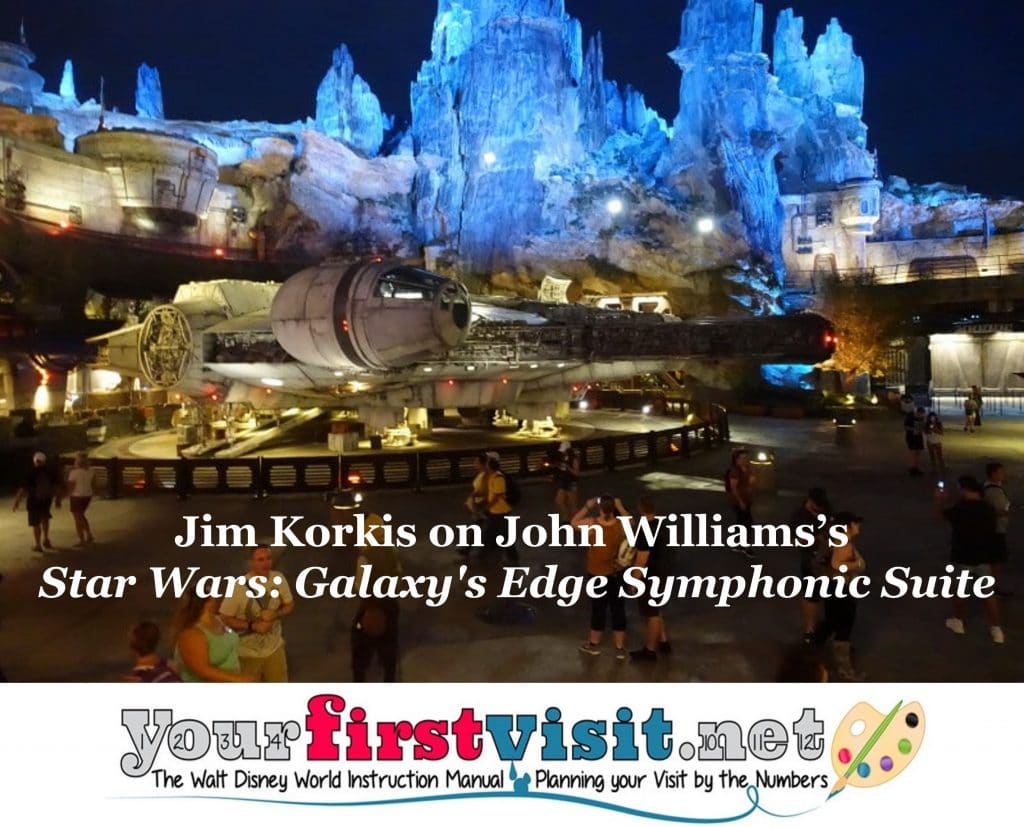
“Williams has always assigned themes and leitmotifs to new characters and planets,” argued John Dennis, executive creative director of music at Imagineering. “You wouldn’t go to Mos Eisley spaceport without hearing that theme. Those are the things we talked to John about, saying … Batuu needs its own identity to give people the emotion that you gave them in all those great cinematic experiences.”
Williams was invited to Walt Disney Imagineering in Glendale for “an in-depth series of meetings,” Walker says. The composer was shown elaborate models, given detailed descriptions, saw artists’ drawings, and was generally introduced to the Black Spire Outpost and its two planned rides, Smugglers Run and Rise of the Resistance.
“We wanted to enhance the immersive-theater quality of the land with a new composition, and that seemed to intrigue him,” says Walker. “It didn’t have anything to do with money or legacy or anything. It was about: Oh, there’s some unfinished business there.”
He went off and composed, in Walker’s words, “a five-minute symphonic tone poem” filled with brand-new themes and motifs. William Ross recorded that suite with the London Symphony Orchestra, who were the original interpreters of “Star Wars” music at Abbey Road Studios from 1977 to 2005.
(Among Ross’s other credits including conducting parts of The Force Awakens and The Last Jedi, Ross was responsible for adapting Williams’ music from the “Star Wars” films for the Star Tours attraction, fireworks shows and other Disney projects.)
In July 2018, John Williams delivered “this five-minute symphonic suite with multiple themes, development of those themes, counter-melodies, even a fugal moment,” Walker said. “The suite just fit the land perfectly. It was mysterious and kind of haunting, but parts of it were powerful and noble.”
Williams, who was in Tanglewood, Massachusetts, at the time of the recording, was linked to Abbey Road, enabling him to hear the sessions and offer specific notes about the performance. Williams said he hoped “listening to the music will take us out of the corporeal world for five minutes…just as these films have done.”
Williams won the 2020 Grammy Award for Best Instrumental Composition for the five-minute Star Wars: Galaxy’s Edge Symphonic Suite that is used in short excerpts throughout the land. Conductor Ross recorded the five-minute suite, a two-minute reduction of the main theme, and various shorter pieces based on Williams’ original composition, all totaling about an hour of music.
* * * * *
Thanks, Jim! And come back next Friday for more from Jim Korkis!
In the meantime, check out his books, including his new books Kungaloosh! The Mythic Jungles of Walt Disney World and Hidden Treasures of Walt Disney World Resorts: Histories, Mysteries, and Theming, much of which was first published on this site.
Follow yourfirstvisit.net on Facebook or Twitter or Pinterest!!
August 13, 2021 No Comments
Fridays with Jim Korkis: The Trolls of Norway in Epcot
Welcome back to Fridays with Jim Korkis! Jim, the dean of Disney historians, writes about Walt Disney World history every Friday on yourfirstvisit.net.
THE NORWAY PAVILION TROLLS
By Jim Korkis
In June 2021, the beloved giant troll who is a favorite photo opportunity location for guests returned to its original location in the Fjording shop after some extensive renovation of the store in the Norwegian Pavilion at Epcot.
Scandinavian folklore has two kinds of trolls: the giants (often called jontar) and the smaller folk called huldrefolk. The jotnar borrow their name and many of their characteristics from the mythology of the ancient Norse ice giants.
They tower above an average person and have rugged features with wild hair. Generally, they were considered primitive, dim-witted creatures. They have a total of eight fingers and eight toes.
That giant troll in the shop, sometimes referred to as “the forgetful troll” because he never remembers when the morning arrives his name or that he came to life during the night, was designed by artist Bjorn Schultze of Ny Form Trolls, a company started in 1964 that specialized in making authentic handmade trolls.
There are ten other huge duplicates of this same troll found around the world, including one on display in Voss, Norway at the Flam Railway, except that one is fully painted and has hair.
Trolls are very common in Scandinavian myths and tales, and are generally unpleasing in appearance. They often live in mountain caves, under bridges, or at the bottom of lakes. A huge variety of trolls roam Norway and some can have up to nine heads.
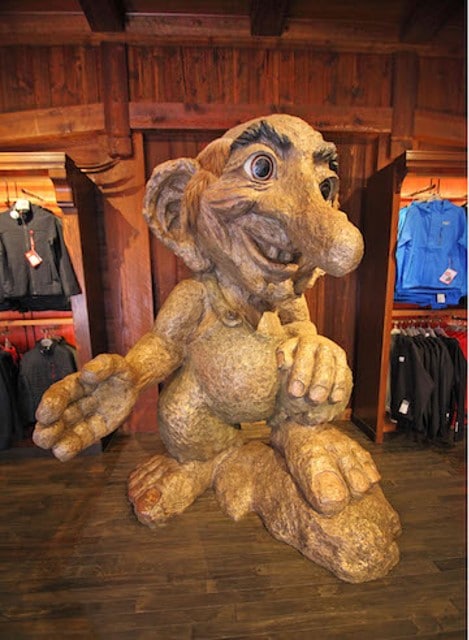
(c) Disney
An entire section of the shop is devoted to different trolls that can be purchased, but trolls are also hidden throughout the Norwegian pavilion.
At one point, Disney publicity told the media that more than twenty trolls were hidden in the pavilion but they often changed locales. The press release also emphasized that while trolls are known for mischief and pillaging, “all of Epcot’s trolls are friendly and those that might be feisty turn to stone when exposed to sunlight.”
The official opening and dedication of the Norway Pavilion was on Friday June 3, 1988. Then-Crown Prince Harald V (who has been King since 1991) and his wife Sonja of Norway dedicated the location.
“We think the pavilion will make Norway much better known,” said Gunnar Jerman, president of NorShow, a group of eleven different companies sponsoring the pavilion along with the country.
NorShow gave the Imagineers a list of items they wanted shown in the Maelstrom attraction that they felt uniquely related to the story of Norway including Vikings, a fishing village, a polar bear, an oil rig and, of course, a troll.
The Three-Headed Troll appeared during the troll country scene of the Maelstrom attraction when guests enter the domain of the Jotunn. When it became aware of the human mortals that had trespassed, it became angered and its heads began talking to one another.
The troll uses its magical abilities on the boat and the vehicle begins to move briefly outside over a waterfall and then back into the attraction and rapidly backwards thanks to hidden conveyor belts. Its design was inspired by the artwork of early 20th century illustrator John Bauer.
The troll’s magic effect was repurposed in the new Frozen Ever After attraction for the magical powers of Elsa. A tapestry within the Royal Sommerhaus where Arendelle royalty can be found depicts the trolls. The tapestry shows the troll’s three heads looming overtop of a waterfall with the rock-troll from the ride at the bottom of the falls. The swirling magic of the trolls appears overhead of them.
The Kringla Bakeri Og Kafe offers the Troll Horn, a sugar-coated cone-shaped pastry shell filled with jam and whipped cream. It was originally known as a Cloudberry Horn, filled with cloudberry jelly.
As the Disney merchandise proclaims: “The only way is Trollway.”
* * * * *
Thanks, Jim! And come back next Friday for more from Jim Korkis!
In the meantime, check out his books, including his new books Kungaloosh! The Mythic Jungles of Walt Disney World and Hidden Treasures of Walt Disney World Resorts: Histories, Mysteries, and Theming, much of which was first published on this site.
Follow yourfirstvisit.net on Facebook or Twitter or Pinterest!!
August 8, 2021 No Comments
A Friday Visit with Jim Korkis: The Unofficial Disney Parks Cookbook
Welcome back to Fridays with Jim Korkis! Jim, the dean of Disney historians, writes about Walt Disney World history every Friday on yourfirstvisit.net.
YOUR PERSONAL DISNEY LIBRARY (42)
By Jim Korkis
- The Unofficial Disney Parks Cookbook by Ashley Craft
Sometimes I feel like Rip Van Winkle, who thought he had slept for a few hours, but it turned out to be years. It seems that when I was not looking and blinked my eyes, the marketplace was flooded with both official and unofficial books filled with recipes of food items from the Disney theme parks.
Certainly, food is a major factor not only in enjoying the Disney parks but also in making them unique from some other entertainment venues.
If Walt Disney World Resort was an independent food service company, it would rank 45th among the world’s largest restaurant chains. As an example, 10,000 dessert soufflés a year come out of the oven at Victoria & Albert’s at Disney’s Grand Floridian Resort & Spa.
Mama Melrose’s Ristorante Italiano at Disney’s Hollywood Studios serves 720 pounds of pasta every day. At least 125 orders of meat loaf and mashed potatoes are requested every day at the 50’s Prime Time Cafe at DHS.
Walt Disney World produces huge quantities of its food items every day. When you try to recreate one of these items at home, you quickly find it takes a huge investment of time, labor and expense as well as not quite tasting the same as it does in the parks.
Also be advised that you might need some additional kitchen items to complete a recipe. It is cheaper and easier to just get it at the park. However, if you are unable to go to a Disney park to get your favorite treat, these recipe books are a good alternative.
I picked The Unofficial Disney Parks Cookbook to review because it focuses on the parks with over a hundred pages (divided into Magic Kingdom, Epcot, Disney Hollywood Studios and Disney Animal Kingdom) of its 229 pages devoted to just Walt Disney World.
The other two chapters are for Disneyland and Disney California Adventure. The first forty or so pages of the book are devoted to a short history of each Disney park in the book and the tools that will be needed in your kitchen to make some of the recipes. Scattered throughout the book are occasional “Did You Know?” paragraphs.
I also picked this book because it had over five thousand five-star reviews on Amazon. The few negative reviews for the book were buyers who tried the recipes and were disappointed for a variety of reasons.
Primarily the negative concerns were that quantities for some ingredients were incorrect, or that recipes were not done from scratch but rather made use of pre-mixed things. I am not a cook nor a baker, so I have not tried to make any of the recipes in this book.
I found the price for The Unofficial Disney Parks Cookbook very reasonable considering it features one hundred recipes and the interior is beautifully designed. The color photos are of Ashley’s creations of the Disney food and not every recipe features a photo.
The recipes are generally for the simpler items like Dole Whip, Blue Milk, and Turkey Legs. In addition, the vast majority of recipes are desserts rather than savory treats.
Author Ashley Craft grew up in Anaheim, California with frequent visits to Disneyland. When she was older she did two internships at Walt Disney World. She has her own blog AshleyCrafted.com where she began sharing recreated Disney park recipes.
* * * * *
Thanks, Jim! and come back next Friday for more from Jim Korkis!
In the meantime, check out his books, including his new books Kungaloosh! The Mythic Jungles of Walt Disney World and Hidden Treasures of Walt Disney World Resorts: Histories, Mysteries, and Theming, much of which was first published on this site.
Follow yourfirstvisit.net on Facebook or Twitter or Pinterest!!
July 30, 2021 No Comments
Fridays with Jim Korkis: The Diamond Horseshoe Revue
Welcome back to Fridays with Jim Korkis! Jim, the dean of Disney historians, writes about Walt Disney World history every Friday on yourfirstvisit.net.
THE DIAMOND HORSESHOE REVUE IN FRONTIERLAND
By Jim Korkis
Entertainment is coming back to Walt Disney World, but some offerings will not return, including one of my all-time favorites that disappeared over thirty years ago.
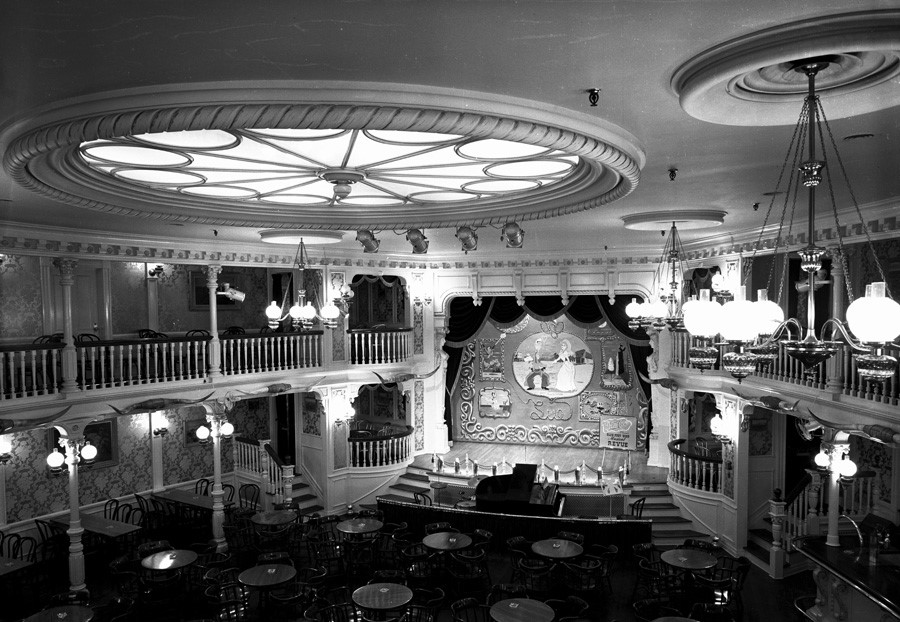
Disneyland version (c) Disney
The Golden Horseshoe Revue was a popular musical entertainment attraction and food and beverage location in Frontierland at Disneyland that premiered opening day in 1955. The music for the show, including Hello, Everybody!, was written by Charles LaVere, who served as the show’s original pianist, and had lyrics by Tom Adair. The script for the production was co-authored by two of its stars, Wally Boag and Donald Novis.
A duplicate of the show called the Diamond Horseshoe Revue (directed and performed by Boag) opened in Frontierland at Walt Disney World on opening day in 1971. The park brochure described it as “a rollicking stage show right out of the Old West featuring a cast of dancing girls, comedians and singers including Slue Foot Sue herself.”
It ran until October 1, 1986, when it became the Diamond Horseshoe Jamboree with Sam the bartender and Miss Lilly that ran until 1995. Several other shows and food service options occupied the location until it became a seasonal only venue.
The interior of the traditional circa 1860 saloon featured a raised stage for the performers, with a small three-piece band on the floor in front of it. There were round tables and wooden chairs on the main floor for guests, with seating also available in a horseshoe-shaped balcony area.
While the show was free, because of limited seating of less than a thousand guests a day even with multiple shows, tickets had to be obtained early in the morning at the hospitality desk by the Disneyania Collectibles shop located at Town Square in Main Street..
Guests could purchase soft drinks, cold sandwiches and chips. The income from the food service rarely covered the cost of the food labor, much less that of the performers, which was one of the reasons for the show closing. It lasted as long as it did because it was a favorite show of Vice President Dick Nunis, who ran the parks. The show was sponsored by Del Monte from 1979 -1984.
Other than being larger physically, the only major change in the Diamond Horseshoe at Walt Disney World compared to Disneyland was that the bar was located on the left side of the room rather than the right as in Disneyland. When Boag returned to California late in 1973, he was replaced in Florida by Bert Henry who had been replacing him at Disneyland.
The roughly thirty-minute show always played to full audiences. Owner Slue Foot Sue and her four dancing girls welcomed the audience in song. She later introduced the emcee and Irish tenor who sang a song. A comedic traveling salesman did a comedy routine that included making balloon animals.
Sue and the emcee sang the song Pecos Bill from the Disney animated featurette and were interrupted by the re-appearance of the traveling salesman now attired as the iconic cowboy of folklore. One of the memorable moments was Pecos Bill being accidentally hit in the face and spitting out his “teeth” at the audience that were actually beans hidden in his mouth. The finale featured Sue’s girls doing a can-can dance and the entire company in a final song.
In August 1986, Dennis Despie, vice president of entertainment for Disneyland and Walt Disney World, said about the show closing, “We all recognize the revue at the Golden Horseshoe and Diamond Horseshoe Saloon as one of the most enduring shows in the history of the park. At the same time, we feel we should now develop a new generation of shows.”
Regrettably, no new show has been introduced to the location.
* * * * *
Thanks, Jim! And come back next Friday for more from Jim Korkis!
In the meantime, check out his books, including his new books Kungaloosh! The Mythic Jungles of Walt Disney World and Hidden Treasures of Walt Disney World Resorts: Histories, Mysteries, and Theming, much of which was first published on this site.
Follow yourfirstvisit.net on Facebook or Twitter or Pinterest!!
July 23, 2021 No Comments
Fridays with Jim Korkis: Solar Energy at Walt Disney World and Vero Beach
Welcome back to Fridays with Jim Korkis! Jim, the dean of Disney historians, writes about Walt Disney World history every Friday on yourfirstvisit.net.
SOLAR ENERGY IN WALT DISNEY WORLD AND VERO BEACH
By Jim Korkis
Walt Disney World has always tried to be environmentally innovative. In terms of solar power, Epcot’s Universe of Energy pavilion (now closed) was designed and constructed with two acres of solar panels on the roof to partially provide power for the attraction when it first opened in 1982.
In April 2018, the Disney Company started building a giant new solar farm in Walt Disney World in collaboration with Reedy Creek Improvement District and solar developer Origis Energy USA. The 270-acre, 50-megawatt solar facility is expected to be able to generate enough clean renewable energy to power two of Walt Disney World’s four theme parks.
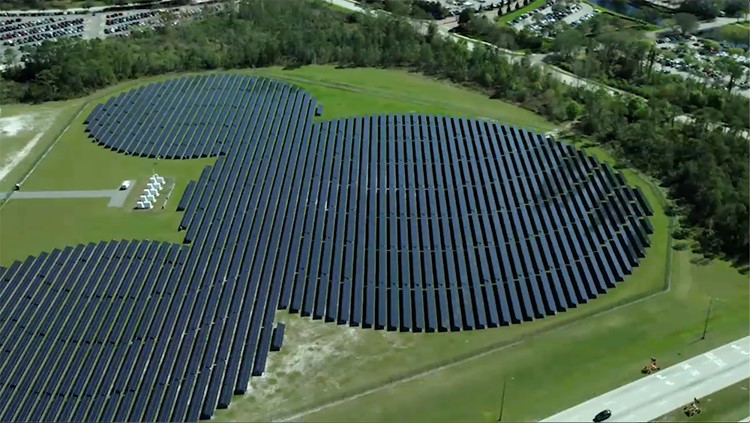
(C) Disney
During peak sun hours, the solar power is estimated to provide 25% of the Walt Disney World resort’s entire power needs, or roughly 120,000 megawatt hours of power. According to Disney, the solar farm includes over a half million solar panels. Switching to solar power will reduce Disney’s greenhouse gas emissions by more than 57,000 tons per year. That’s equal to taking 9,300 automobiles off the roads.
Construction for the huge 270 acre facility was on a site near Disney’s Animal Kingdom. The existing “Hidden Mickey” Epcot solar farm is a mere 22 acres by comparison.
That Epcot facility is operated by Duke Energy as part of a fifteen year agreement and is made up of 48,000 solar panels in the shape of a classic three-circled Mickey Mouse head. It generates five megawatt hours of power. WDW already buys some power from Duke.
In 2010, thirty solar panels were installed to heat water used in the guest rooms, two restaurants and other common areas at the main building at Disney’s Vero Beach Resort.
Water flowing through copper tubes embedded inside the solar panels is heated by the sun, decreasing the need for propane. The system is similar to one installed in 2008 to heat water in the Costuming building at the Magic Kingdom and the Animal Nutrition Center at Disney’s Animal Kingdom.
“We were excited to be able to test the thermal solar panels first at the two Cast Member locations,” said Paul Allen, chief Energy Management engineer at Reedy Creek Energy Services. “The test was successful and water is still being heated by the sun at these locations. We were thrilled that the team at Disney’s Vero Beach Resort wanted to expand this program by installing the panels at their resort.
“While there are many photovoltaic solar panels on property, the panels in use at the two Cast locations and now Disney’s Vero Beach are our first thermal hot water-solar installations.”
The intention was that the solar panels should help significantly reduce the resort’s propane costs.
“The propane system is still in place, but it is only used as a backup to automatically provide hot water if demand exceeds availability,” said Steve Boll who headed Engineering Services at Vero Beach. “We have estimated the amount of solar hot water produced to be about 40 percent of total hot water needs for the main building.”
Additional efforts at the resort include the installation of heat-pipe systems, upgrades to guest room thermostats and energy-management-system controls. The heat-pipe system was installed on two air-conditioning units to provide a more energy-efficient way to dehumidify the air in the main building.
The new guest thermostats automatically set the temperature back to temperatures specified by the Disney company energy policies when guests are not in the room. Upgraded energy-management controls were installed on several large air-conditioning systems serving the resort’s meeting spaces and restaurants to improve guest comfort and energy savings.
* * * * *
Thanks, Jim! And come back next Friday for more from Jim Korkis!
In the meantime, check out his books, including his new books Kungaloosh! The Mythic Jungles of Walt Disney World and Hidden Treasures of Walt Disney World Resorts: Histories, Mysteries, and Theming, much of which was first published on this site.
Follow yourfirstvisit.net on Facebook or Twitter or Pinterest!!
July 19, 2021 No Comments
Fridays with Jim Korkis: Toy Story Mania!
Welcome back to Fridays with Jim Korkis! Jim, the dean of Disney historians, writes about Walt Disney World history every Friday on yourfirstvisit.net.
TOY STORY MANIA! IN DISNEY’S HOLLYWOOD STUDIOS
By Jim Korkis
With the opening of Toy Story Land in Disney’s Hollywood Studios, the Toy Story Mania! attraction was re-themed with a new entrance to look like walking into a carnival game box that’s supposed to be the box that the Toy Story Mania! game came in.
The queue is adorned with super-sized board games and playthings: Crayola crayons, Candyland, Chutes and Ladders, Tinkertoys, Viewmaster reels of Disney animated films, A Barrelful of Monkeys, Checkers, Little Golden Books and much more.
Two new characters were added when the attraction’s Toy Story Land entrance debuted in June 2018: Lenny, Andy’s walking binoculars, and Chuckles the clown, who was introduced in Toy Story 3, are represented in Toy Story Mania! by way of the boxes they originally came in.
With the shift from Pixar Place to Toy Story Land, several changes were made to the games of the attraction to include characters from Toy Story 3. Rex was replaced in the Hamm and Eggs game by Buttercup, a unicorn, while Bo-Peep’s Baaa-loon Pop game was replaced by Rex and Trixie’s Dino Darts.
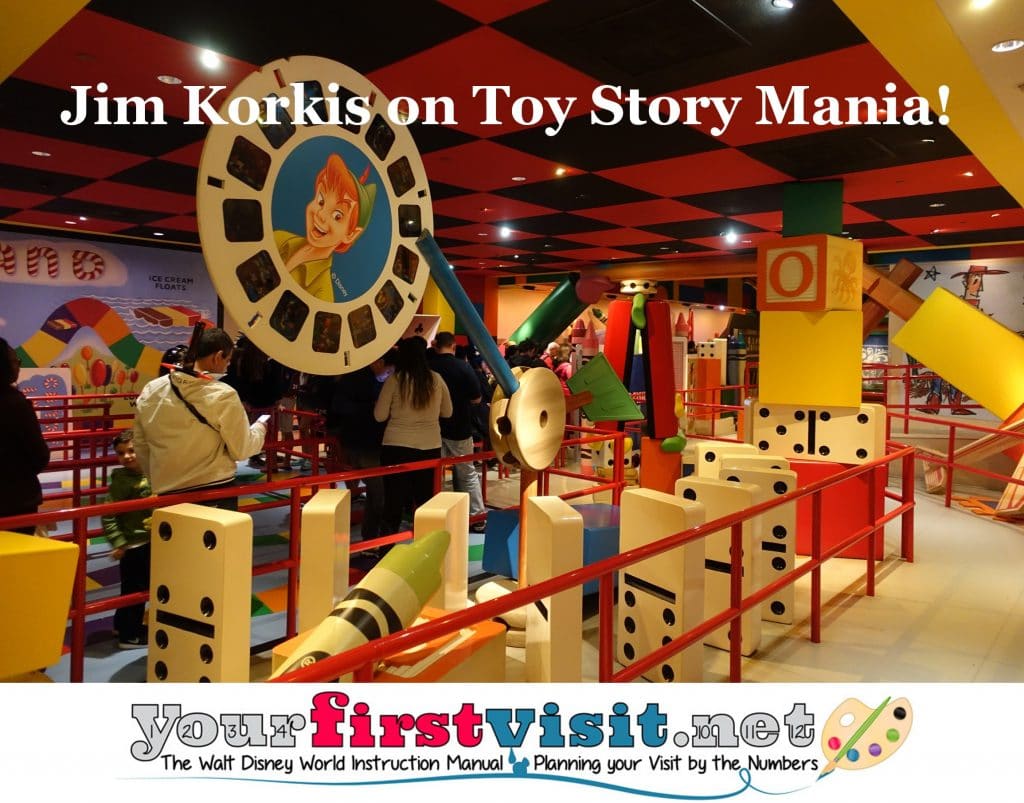
Mr. Potato Head also marked the first Audio-Animatronics figure whose mouth appeared to form words and vowel sounds.
“I think guests will most enjoy Don Rickles’ fast tongue (Rickles provided the voice for the character in all the Toy Story feature films and shorts) and mellifluous movement this figure possesses as it accompanies his voice with both mannerisms and actions,” said Jimmy Thomas, principal Manufacturing technical and mechanical designer for Mr. Potato Head.
“There are too many different things to list from a technical standpoint by comparison to any other audio-animatronics figure that we have built thus far at Imagineering.”
The loading area of Toy Story Mania! is themed as the floor of Andy’s room with the iconic blue cloud wallpaper, Andy’s bed and dresser, and books and toys along the walls, so the guest seems to have shrunk to the size of a toy. The murals located in the load area are the biggest attraction murals painted since Epcot was built.
Guests are situated back-to-back four to a vehicle so everyone has a front row seat. A computer prompts various sounds, lighting and other themed effects depending on where the vehicle is along the track.
Each vehicle consists of four “spring-action shooters” used throughout the attraction to launch virtual darts at balloons, rings around aliens and eggs at barnyard targets. With 56 screens programmed with 3-D animation from Walt Disney Pixar Animation Studios, each game lasts approximately thirty seconds.
“With the use of more than 150 computers over various networks, the technology in this attraction makes it feel like it’s never the same experience twice,” said Walt Disney World Senior Engineer Jose Corpuz.
Another innovation was an offline loading area for guests with disabilities.
“As a result of this unique approach to accessibility, guests traveling in wheelchairs or using other mobility aids such as walkers, canes or crutches have as much time as they need to board either a specially designed Wheelchair Accessible Vehicle or to transfer into a standard vehicle,” said Mark Jones, Operations manager, Walt Disney World Services for Guests with Disabilities.
* * * * *
Thanks, Jim! And for more on Toy Story Land, see this.
And come back next Friday for more from Jim Korkis!
In the meantime, check out his books, including his new books Kungaloosh! The Mythic Jungles of Walt Disney World and Hidden Treasures of Walt Disney World Resorts: Histories, Mysteries, and Theming, much of which was first published on this site.
Follow yourfirstvisit.net on Facebook or Twitter or Pinterest!!
July 9, 2021 No Comments



